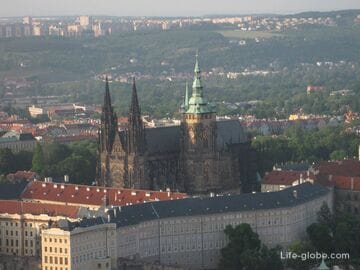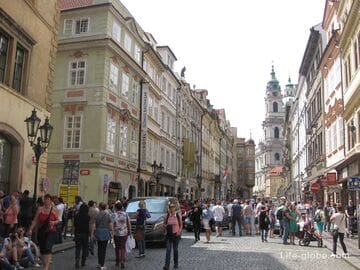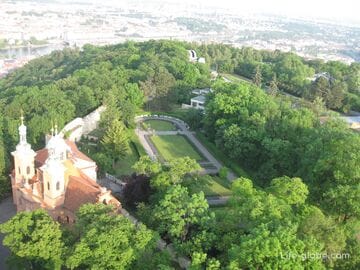Josefov (Josefov / Josefov) - The Jewish Quarter or the Jewish City (Židovská čtvrť) is a small quarter in Prague, which was the former Jewish ghetto of the city, in which Jewish monuments are now preserved: the Jewish town hall, synagogues, a museum and a Jewish cemetery.
Today, the Jewish quarter is one of the most visited places in Prague.
The name of the quarter "Josefov" (city of Joseph) comes from the name of Emperor Joseph II, whose reforms improved the living conditions of Jews in Prague.
The history of Jews in Prague dates back to the 10th century, and Josefov fully appeared in Prague in 1850, during the transformation, when the Prague Jewish ghetto officially became one of the administrative quarters of the city, and the Austrian Emperor Joseph II issued decrees on equalizing the rights of Jews with the Christian population.
Most of the block was demolished between 1893 and 1913 as part of an initiative to model the city on the model of Paris. After that, only a few synagogues, an old cemetery and an old Jewish town hall remained from the vast Jewish part of the city, most of which are now part of the Jewish Museum in Prague (Židovské muzeum v Praze), which, in turn, is one of the oldest Jewish museums in Europe, founded in 1906.
Currently, Josefov is built up mainly with buildings of the early 20th century, but also in the quarter you can see the "old witnesses of history" - the remains of the former Jewish ghetto of Prague. Guided tours are conducted around the quarter.
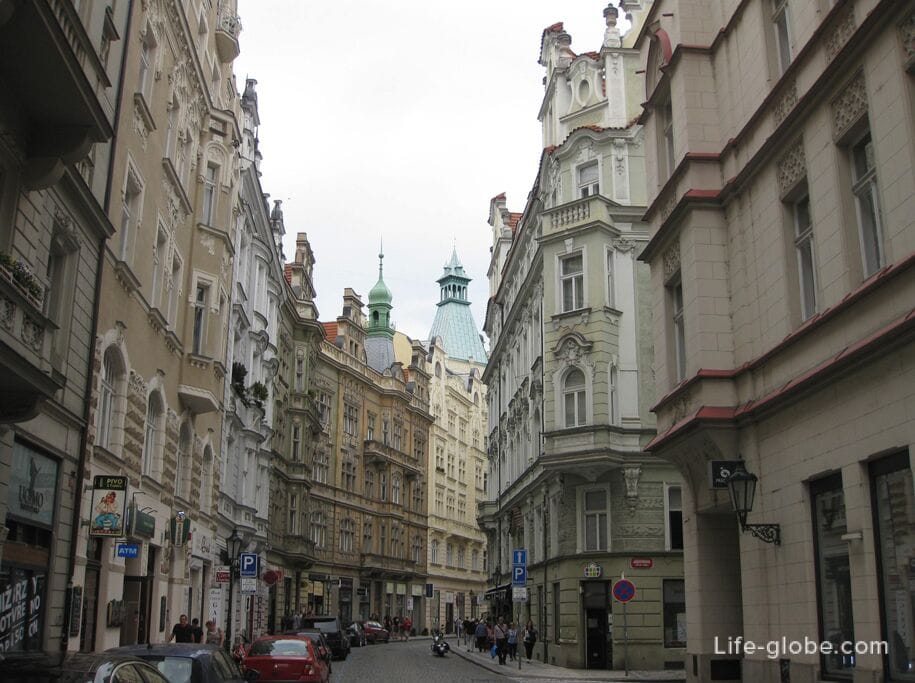

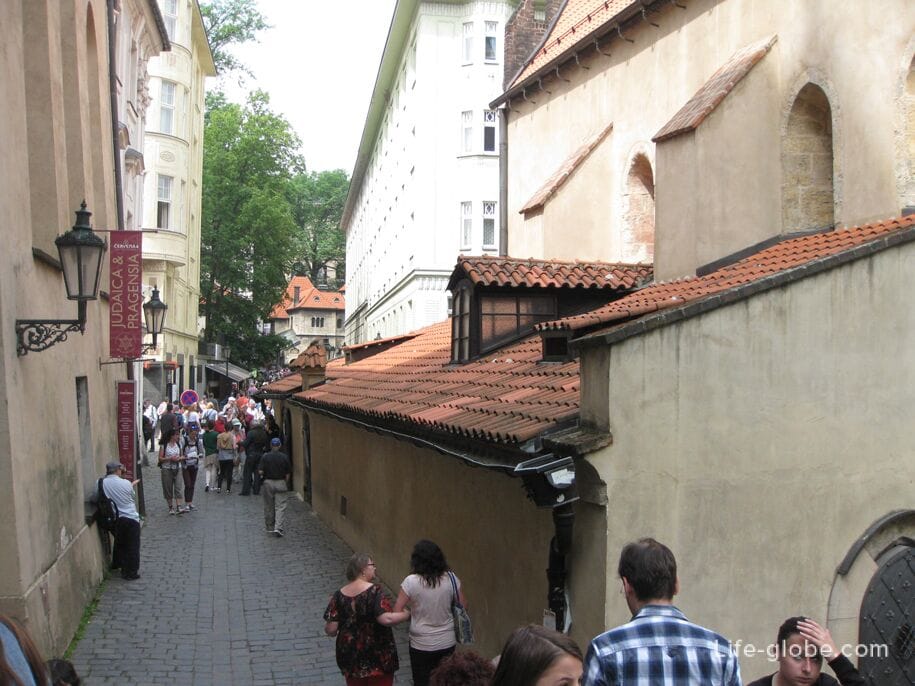
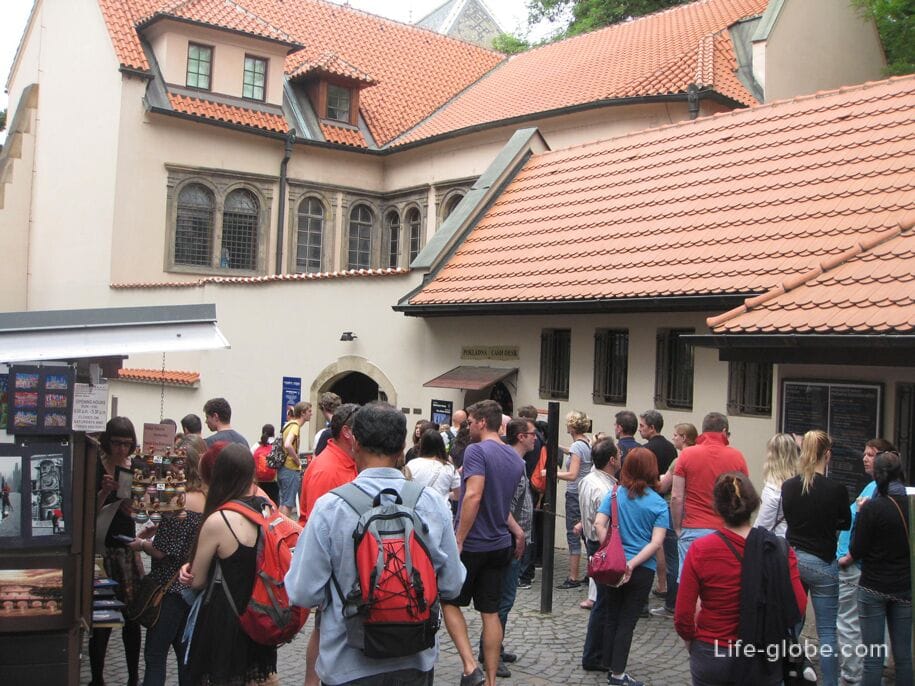
The Jewish Quarter is located between the right bank of the Vltava River and Old Town Square.
The central street of the Jewish quarter can be considered Paris Street (Pařížská ulice) with elegant buildings and boutiques.
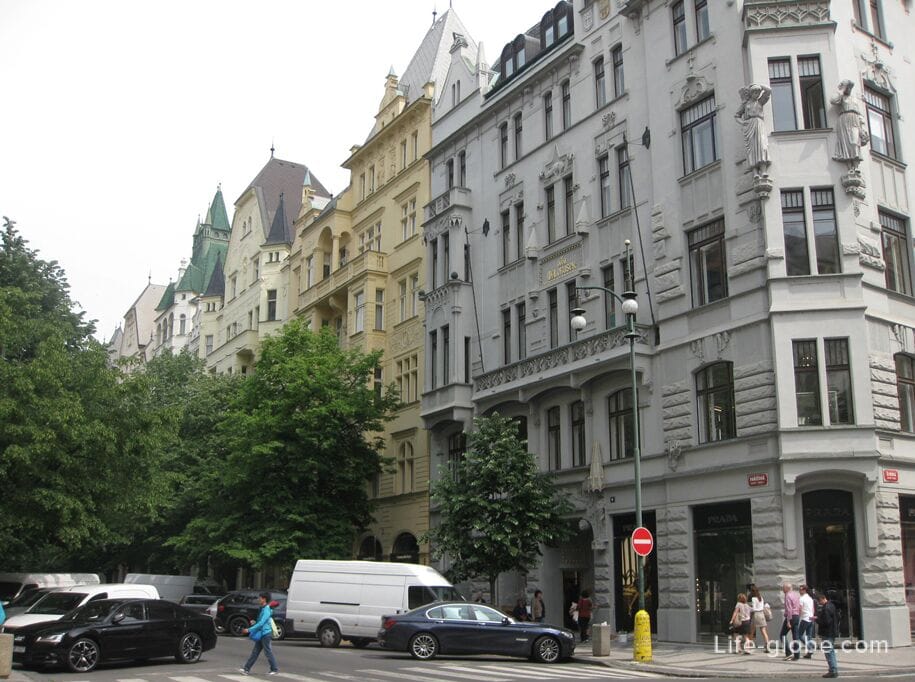
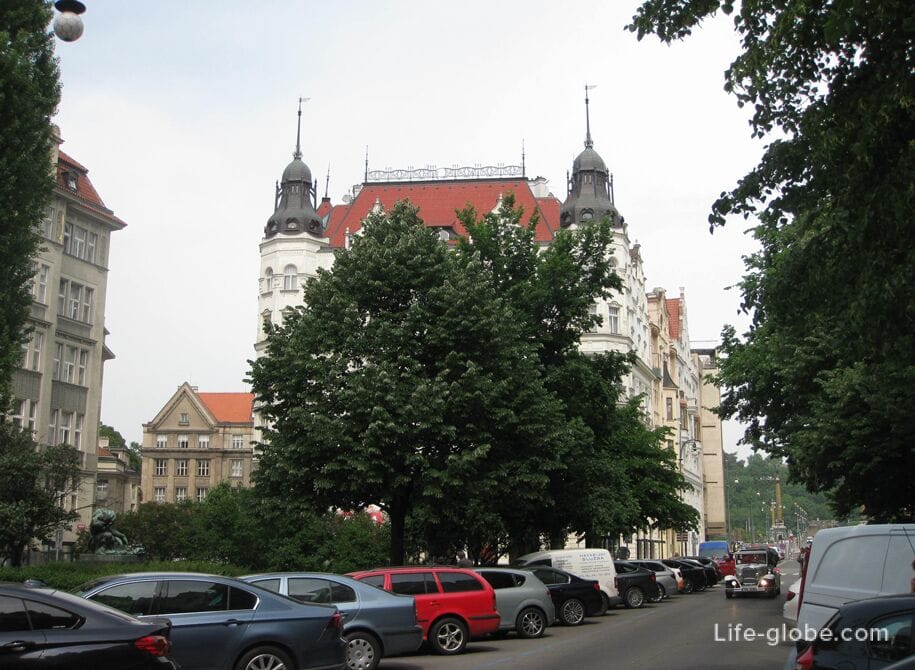
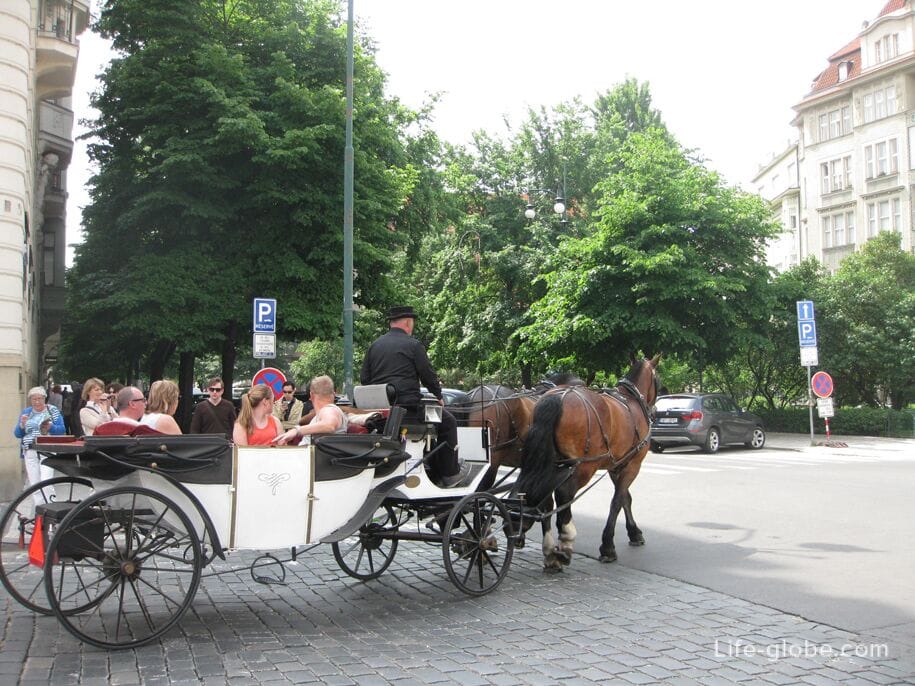

A bronze sculpture of Moses (Socha Mojžíše), by Czech sculptor František Bilek, is installed in a small green area on Prague Street.
The statue represents Bilek's original vision of the Old Testament prophet: a life-size kneeling man writes the name ADAM on a scroll as a symbol of humanity, for which he is responsible, and who is looking for the promised land. Bilek created the statue back in 1905. It was installed at its current location in 1937. During the Nazi occupation, it was removed and then melted down. After the war, in 1946, the sculpture was cast again according to the original plaster model, and then returned to its former place.

At the beginning of Maiselova ulice, a memorial plaque of Franz Kafka with his relief portrait (Geburtshaus Franz Kafka) is placed on the corner of house No. 2.
In this place (the Jewish ghetto) There was an old house in which the world-famous writer Franz Kafka was born on July 3, 1883. He lived here with his parents until 1885, when he moved into a house on Wenceslas Square.
The old house was demolished, and a new one was erected in its place, on the facade of which a memorial plaque was installed.
A plaque and the name of a nearby square are dedicated to the memory of Franz Kafka.
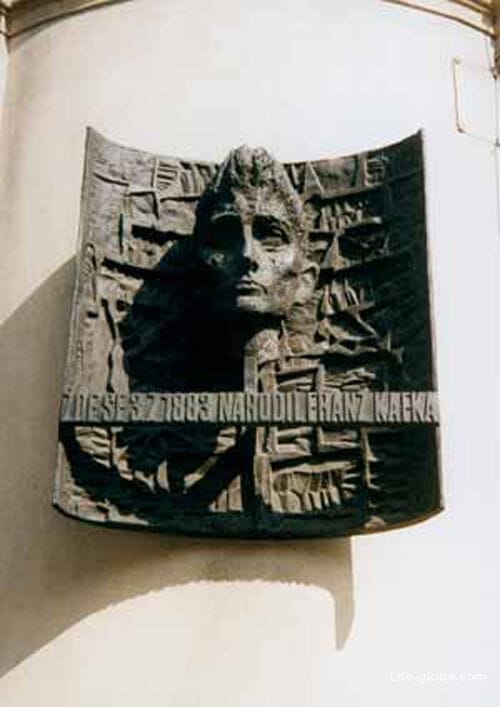
Sights of Josehof
Jewish Town Hall
The Jewish Town Hall (Židovská radnice) was built in 1586 in Renaissance style with the support of Mayor Mordechai Maisel.
The current Rococo facade of the town hall was acquired in the 18th century.
This building was the main meeting place of the local Jewish community.
The Town Hall is decorated with a multi-faceted turret and a clock, some of which are placed on the tower and have a Roman dial, while others are located on the roof of the town hall and are decorated with a Jewish dial. The Hebrew numerals begin with aleph and continue counterclockwise around the clock face.
Address of the Jewish Town Hall: 18, Maiselova 250, 110 00 Praha 1, Czech Republic.
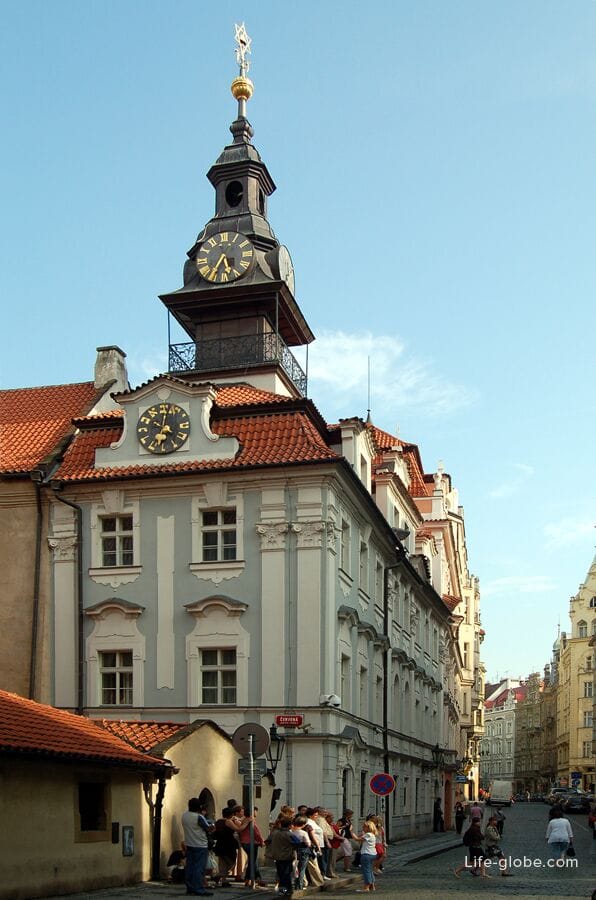
The Old Jewish Cemetery
The Old Jewish Cemetery (Starý židovský hřbitov) is one of the oldest Jewish cemeteries in the world, and together with the Old Synagogue is the most important monument of the Prague Jewish Quarter.
The cemetery was founded in the first half of the 15th century. The oldest tombstone dates back to 1439, the last burial took place 348 years later. The cemetery area has been expanded several times over the centuries. The deceased were buried in the cemetery on ten layers above each other.
There are about 12,000 tombstones in the cemetery, many of which are decorated with symbols of animals and plants. Among the most important burials: scientist and teacher Rabbi Yehuda Lev ben Bekalel named Rabbi Lev (died 1609); scientist and poet Avigdor Kara (died 1439); Aaron Meshulam Horovich, builder of the Pinkas Synagogue (died 1545); primate of the Prague Jewish town and builder of the Maisel Synagogue Mordechai Maisel (died 1601); Renaissance scholar, historian, mathematician and astronomer David Hans (died 1613); collector of Hebrew manuscripts and engravings Rabbi David Oppenheim (died 1736).
The entrance to the cemetery is through the exit at the Klaus Synagogue.
The address of the old Jewish cemetery: vstup Široká 3, 110 00 Praha 1.
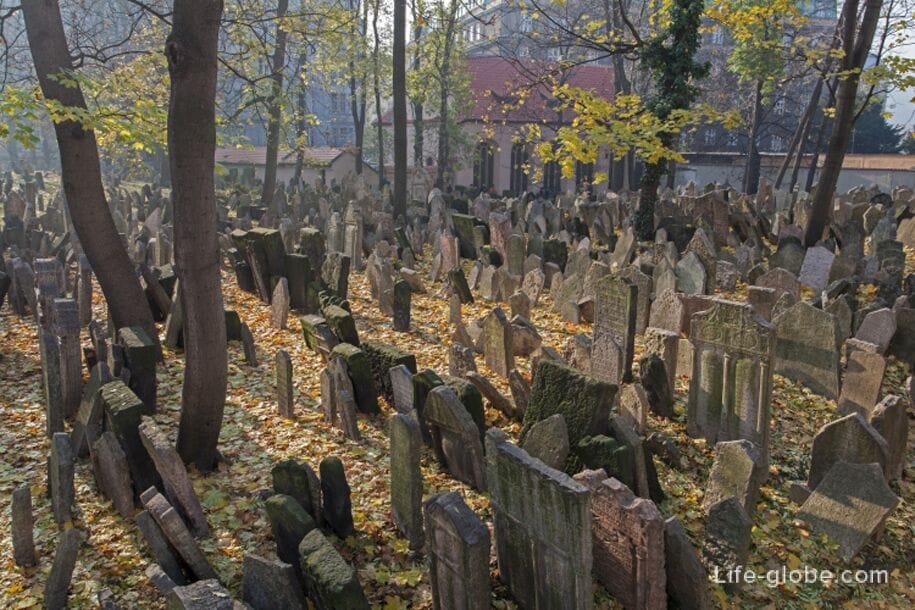
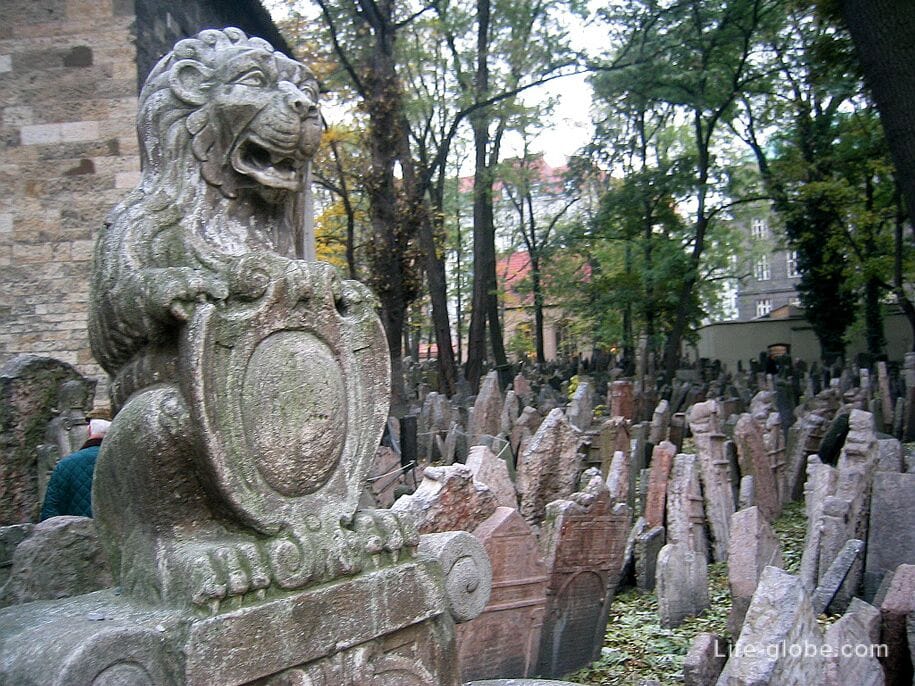
Ceremonial Hall
The Ceremonial Hall (Obřadní sín) is the building of the former ceremonial hall and morgue in the Old Jewish Cemetery.
The building of the Prague Funeral Brotherhood was built in the pseudo-Romanesque style in 1911-1912 by the architect Frantisek Gerstl.
Today it is the exhibition space of the Jewish Museum, which houses the exposition "Jewish Traditions and Customs - the way of life", which is accompanied by paintings from the unique cycle of the Prague Funeral Brotherhood of the 1980s. The main hall displays the brotherhood's help to the sick and dying, ritual ablution of the dead and funeral ceremony. In the next hall, the problems of Jewish cemeteries and tombstones are raised. Another area is reserved for memorial prayers for the deceased, and there are also engravings and paintings on the theme of the old Prague Jewish cemetery. The room on the floor above the stairs is dedicated to the organization, internal life and external representation of funeral fraternities.
Entrance is paid.
The address of the ceremonial hall: Starého hřbitova 3a, Praha 1 - Josefov.
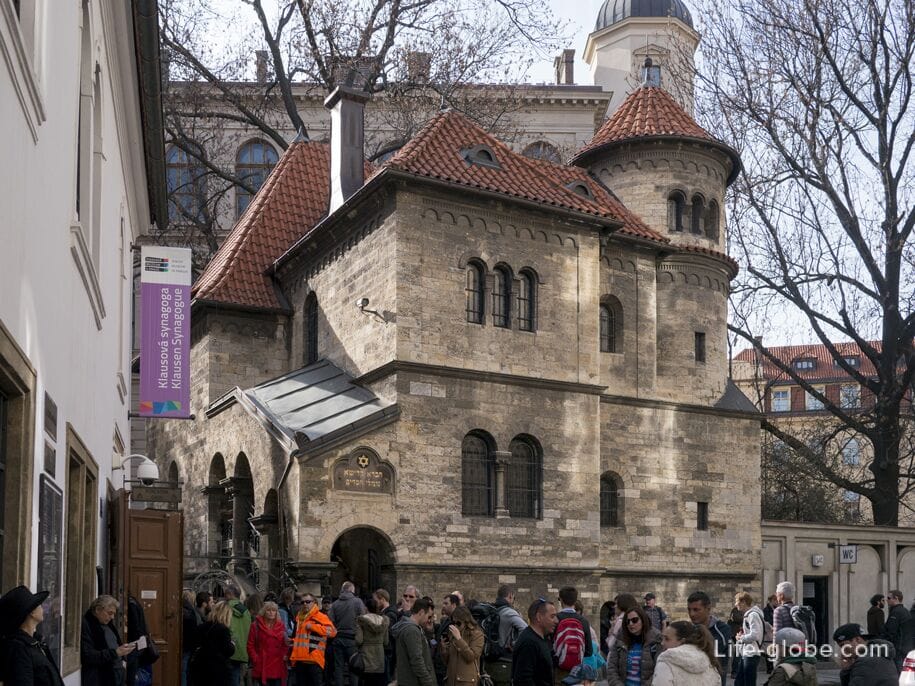
Klaus Synagogue
The Klaus Synagogue or Klausova Synagogue (Klausova synagogue) is the largest synagogue in the Prague Jewish Quarter and the second main synagogue of the Prague Jewish community.
Initially, the synagogue consisted of three parts (buildings) called clauss (claus - cell, room from the Latin "claustrum"), hence the name of the synagogue. One part was founded by Rabbi Lev for the Talmud College, the other was a prayer house, and the third was intended for ritual ablution (mikvah) and nursing.
In 1689, the buildings burned down, and until 1694 a new synagogue was built in the early Baroque style, having a single-nave hall with a barrel-shaped, richly plastered vault with lunettes.
The synagogue was modified in 1882-1883 by architect Bedrzich Munzberger and again after 1921. During the occupation, the interior was destroyed. The next reconstruction of the synagogue took place in 1979-1984 and 1995-1996.
The synagogue houses an exposition of the Jewish Museum dedicated to Jewish traditions and customs. The first part of the exhibition "Jewish Traditions and Customs" is devoted to the issues of worship on weekdays, Shabbat and holidays. Prayer books and ritual items used on weekdays and on Shabbat are placed in the showcases. The second part of the exhibition, entitled "The Run of Life", is devoted to the theme of birth, circumcision and redemption of the firstborn. Another milestone in life that the exhibition is dedicated to is growing up: the customs at engagements and weddings are represented by the Jewish household with an emphasis on typical ritual objects.
Entrance is paid. There is a ticket office and a museum store in the lobby of the synagogue.
Address of the Klaus Synagogue: U Starého hřbitova 3a, 110 00 Praha 1.

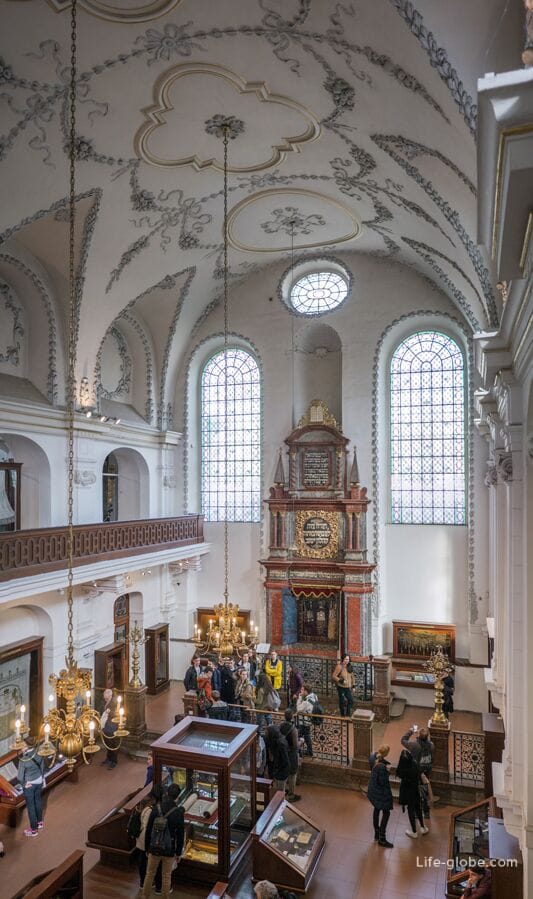
Staronova Synagogue
The Staronova Synagogue or the Old New Synagogue (Staronova Synagogue) is one of the oldest and most valuable Jewish monuments in the world, it is also the oldest operating synagogue in Central Europe. It is also the oldest surviving medieval synagogue with a double nave.
This early Gothic building of the late 13th century (1270) with rich masonry and a high gable roof is today the main functioning synagogue of the Jewish community of Prague.
Inside the synagogue, in the middle of the eastern wall there is a box for Torah scrolls. In the center of the synagogue there is a place for the speaker, fenced with an iron Gothic lattice, at the top there is a historical banner of the Prague Jewish community, with the coat of arms of the ghetto (the Star of David with a Jewish hat inside).
Why the "Old New Synagogue"? Because there was another, older Prague synagogue, known as the Old Synagogue, which was demolished in 1867 and the Spanish Synagogue that exists today was erected in its place.
Entrance for the purpose of tourism to the synagogue is paid. You can purchase a single ticket to the Old and Jerusalem synagogues.
Synagogue Website: .cz/en/old-new-synagogue .
Synagogue address: Červená, 110 01 Josefov, Czech Republic.

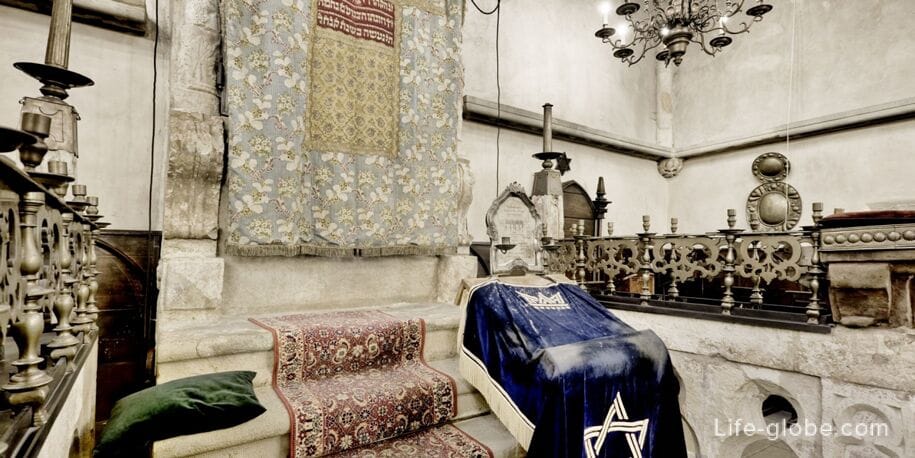

Spanish Synagogue
The Spanish Synagogue (Španělská synagogue) is a synagogue in the Spanish Moorish style, built on the site of the oldest Jewish prayer house "Old School", in 1867-1868, designed by Voytech Ignaz Ullman and Josef Niklas.
The square-shaped neo-Renaissance building has a massive dome in the central space. In the spirit of religious traditions, the interior decoration is exclusively ornamental, the rooms are covered with low Arabesque stucco, stylized with geometric and floral motifs inspired by Islamic architecture, with rich gilding and polychromy, which is repeated in decorative and applied art. The synagogue and stained glass windows attract.
The synagogue houses the exposition of the Jewish Museum in Prague entitled "Jews on Czech Lands in the 19th and 20th centuries", also hosts chamber music concerts and other cultural events.
The exhibition at the synagogue traces the fate of Jews in Czech lands from Josephine's reforms in the 1980s to the post-war period.
Synagogue attendance is paid.
Synagogue address: Dušní 12, 110 00 Praha 1 - Josefov.


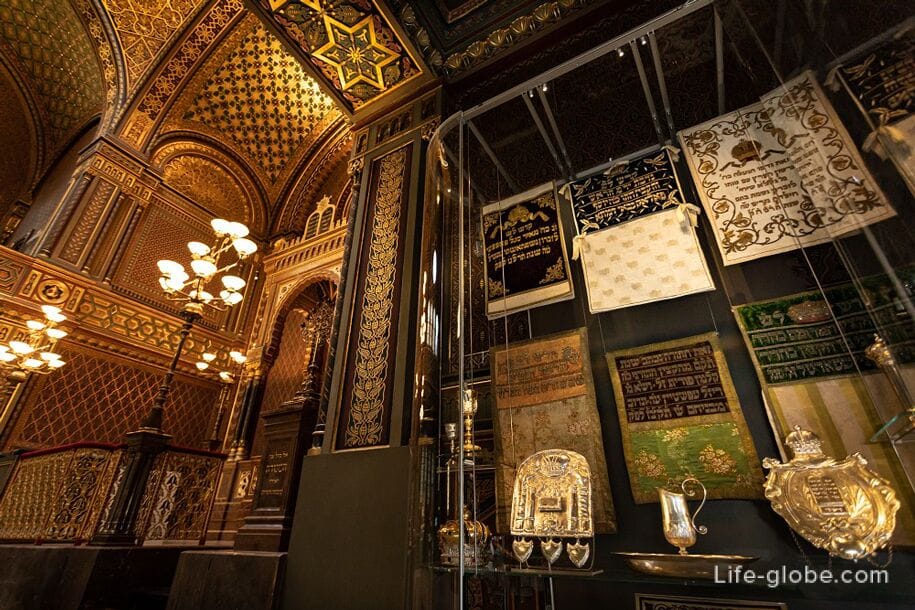

Next to the Spanish Synagogue is the famous monument of Franz Kafka (Socha Franze Kafky) - a rather unusual abstract monument to the writer Franz Kafka based on his story "Description of a Struggle".
The monument was created in 2003 by the sculptor Yaroslav Ron.
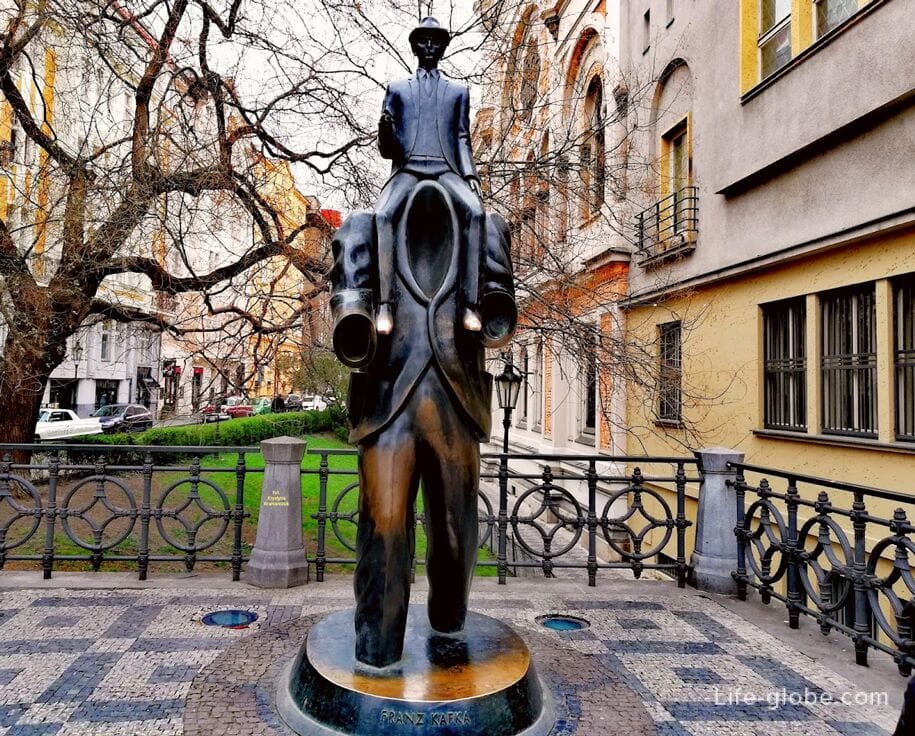
Maisel Synagogue
The synagogue of Maisel (Maiselova synagogue) was built in 1590-1592 by the privilege of Emperor Rudolf II. Its founder was the primate of the Jewish city of Prague, Mordechai Maisel, hence the name of the synagogue.
Builders Judah Koref Hertz and Josef Wahl built an unusual three-nave synagogue in the Renaissance style for that time.
In 1689, the synagogue burned down during a fire in the ghetto and was subsequently rebuilt several times. The restoration of the synagogue in its current Neo-Gothic form according to the project of A. Grotta took place in 1893-1905.
To some guests of Prague, the architecture of this synagogue still seems unusual and charming.
Now the synagogue serves as an exhibition space and a repository of the Jewish Museum, as well as a venue for chamber art performances: music, recitations and one-actor theater.
The permanent exhibition in the synagogue is called "Jews in the Czech Republic 10-18 centuries." At the exhibition, visitors can see an audiovisual 2D projection, thanks to which guests will find themselves on the streets of the old Prague Jewish town, as depicted by the famous Langweil model of Prague. Also in the collection: old Hebrew manuscripts on touch screens and historical plans of Jewish settlements. In the synagogue, you can search the database of important Jewish personalities.
Synagogue attendance is paid.
Synagogue address: Maiselova 10, 110 00 Praha 1.
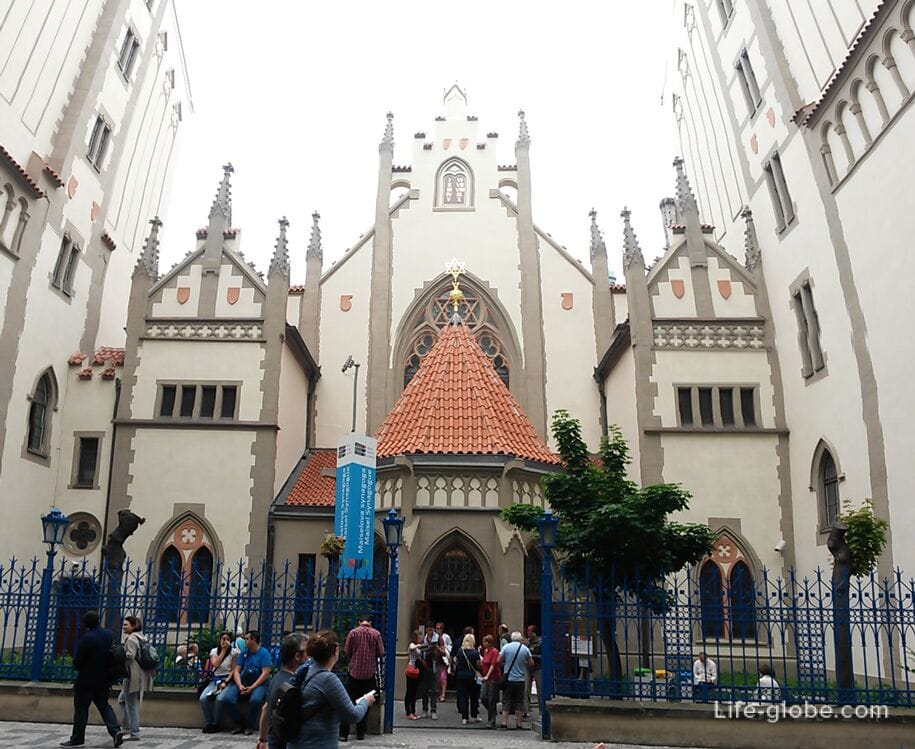
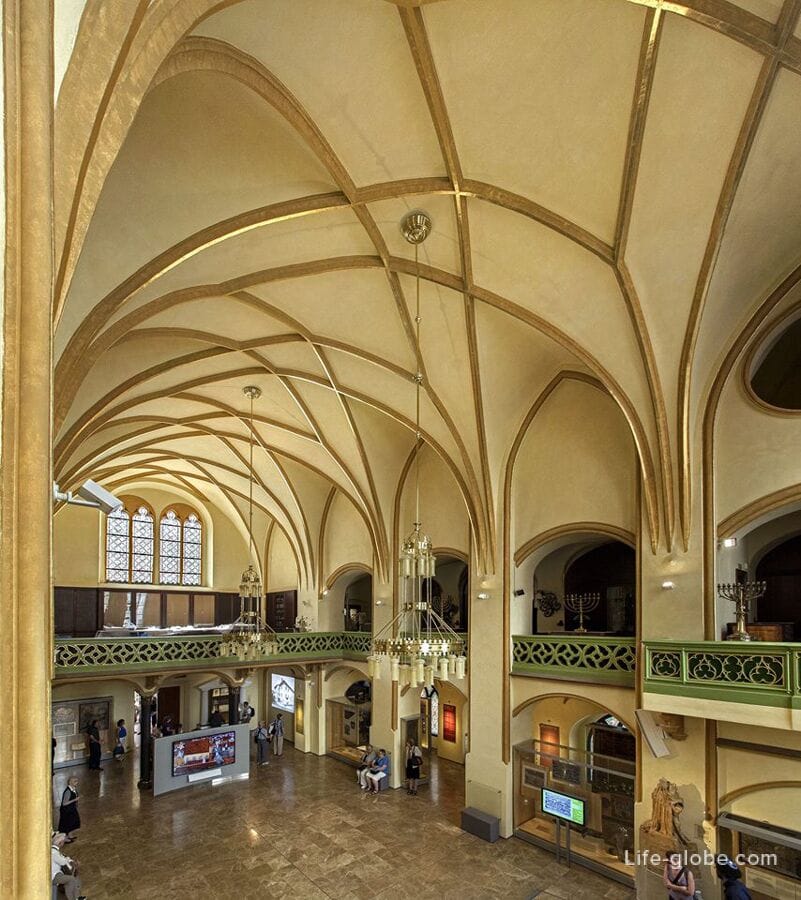
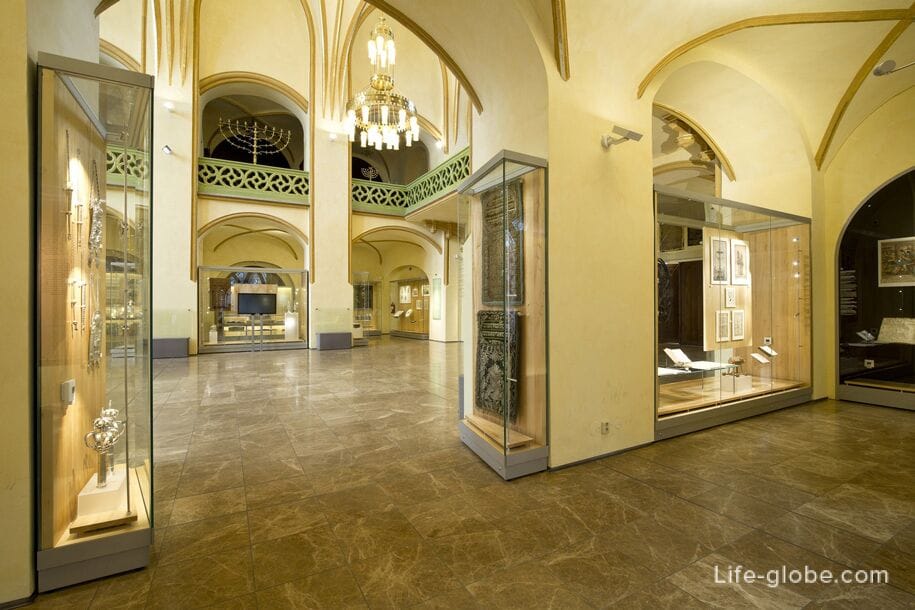
Pinkas Synagogue
The Pinkas Synagogue or Pinkasova Synagogue (Pinkasova synagogue) is the second oldest surviving synagogue in Prague.
The synagogue was built in 1535 in the late Gothic style by one of the important members of the Prague Jewish community, Aron Meshulam Horovich. According to his grandson, Rabbi Pinkas Horowitz, the building probably got its name - "Pinkas School".
The building served as a private family prayer house, and a ritual bath (mikva) was arranged next to it.
The synagogue was restored to its original form in 1950-1954.
Today the synagogue is part of the Jewish Museum.
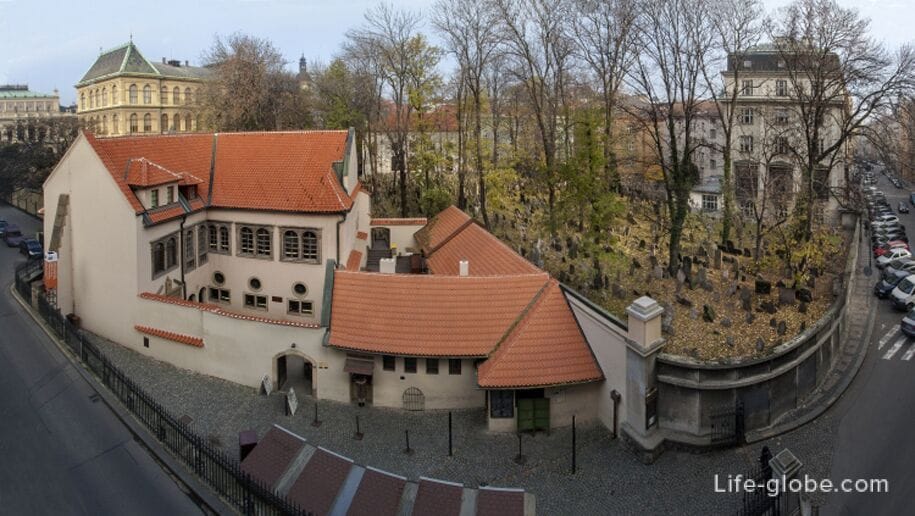

In 1955-1960, the Pinkas Synagogue was transformed into a Memorial to almost 80,000 Czech and Moravian Jews who became victims of the war. The authors of one of the oldest monuments of this kind in Europe are the artists Vaclav Bostik and Jiri Ioann.
The exhibition on the 1st floor tells about the fate of Jewish children imprisoned during the Second World War in the Terezin ghetto. It is based on the world-famous children's drawings created in 1942-1944 in the Terezin ghetto under the direction of the artist Friedl Dicker-Brandeis.
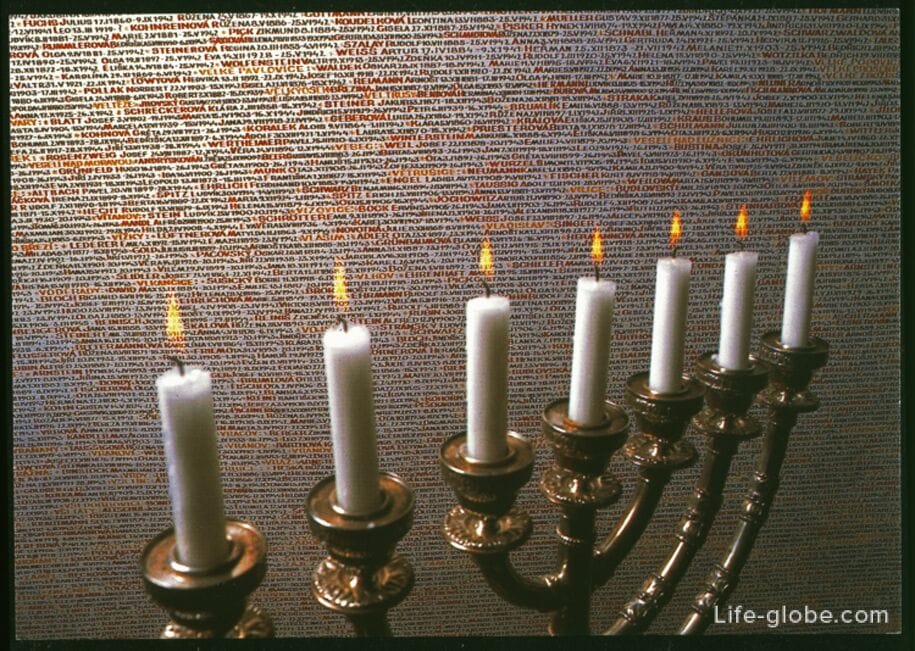
There is also an open-air exhibition dedicated to the deportation of the Jewish population from the Protectorate of Bohemia and Moravia to ghettos, concentration camps and death camps in the occupied territories of Eastern Europe.
The exhibition "The Faces of the Shoah Victims" is an outdoor projection projected in the evening on the pediment of the mikva of the Pinkasov synagogue.
Entrance to the synagogue is paid.
Synagogue address: Široká 3, 110 00 Praha 1.
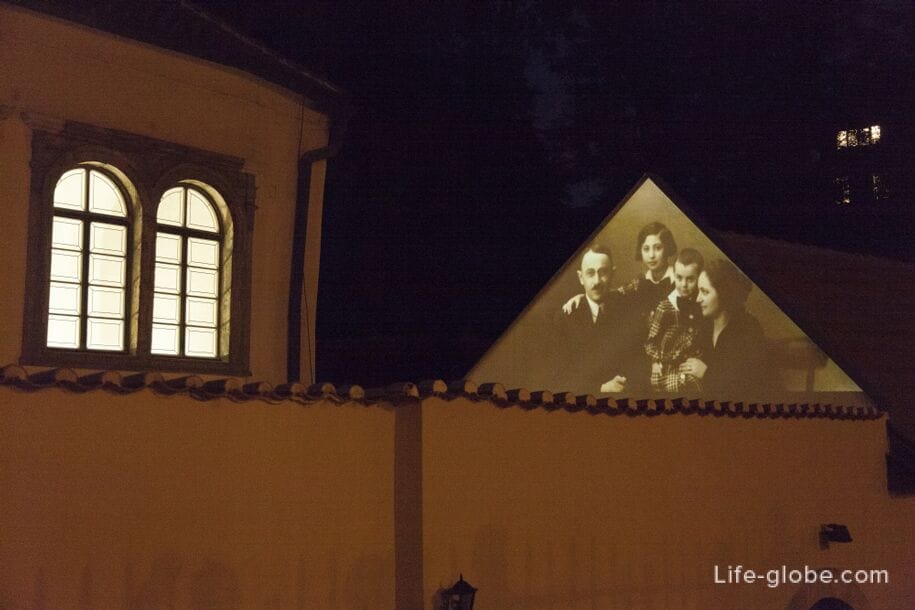
Robert Guttman Gallery
The Robert Guttmann Gallery (Galerie Roberta Guttmanna) is another object in the Jewish quarter of Prague, part of the Jewish Museum.
The gallery is located on the ground floor of the Jewish Museum Complex and is named after the famous Prague naive artist Robert Gutman.
According to the profile of the collections, the short-term exhibitions organized are mainly focused on domestic Jewish artists of the late 19th and first half of the 20th century, but at the same time the gallery strives to present post-war and especially contemporary art.
Entrance to the gallery is paid.
Gallery address: U Staré školy 3, 110 00 Praha 1.
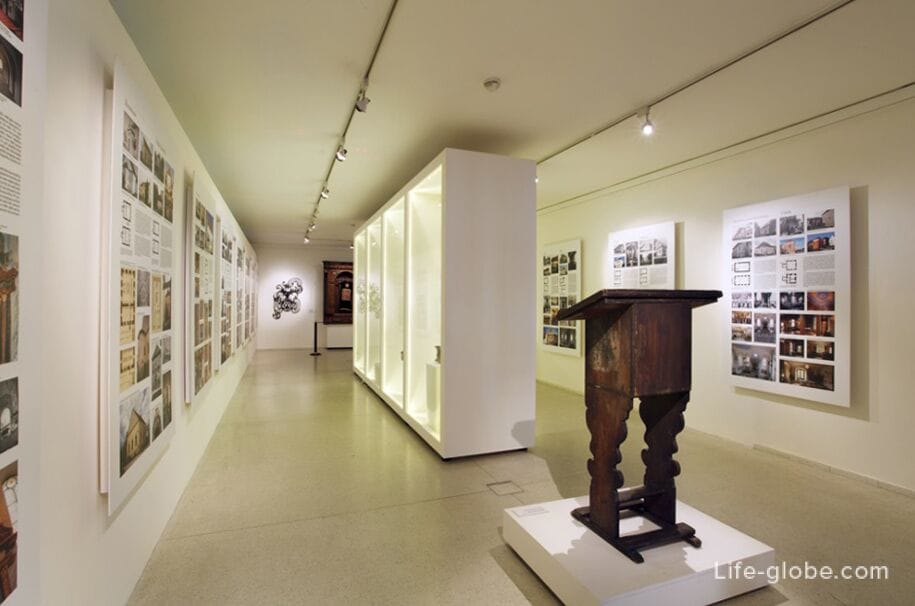
High Synagogue
The High Synagogue (Vysoká synagogue) has a beautiful 19th-century facade and adorns a Prague Street.
The construction of the Renaissance-style synagogue was financed by Mordechai Meisel and was completed in 1568. It is said that this synagogue was built on the model of the High Synagogue in Krakow (Poland), built in 1556. The building was conceived as a place for the sermons of the Jewish Town hall councillors.
In 1689, the synagogue was destroyed by a Great Fire, and then reconstructed. In 1883, the synagogue was rebuilt by I.M. Wertmuller, during which the shrine acquired its current exterior.
During the Nazi and Communist rule, the synagogue was part of the Jewish Museum, where an exhibition of old Jewish books functioned.
Synagogue address: Červená 98, 110 00 Staré Město, Czech Republic.
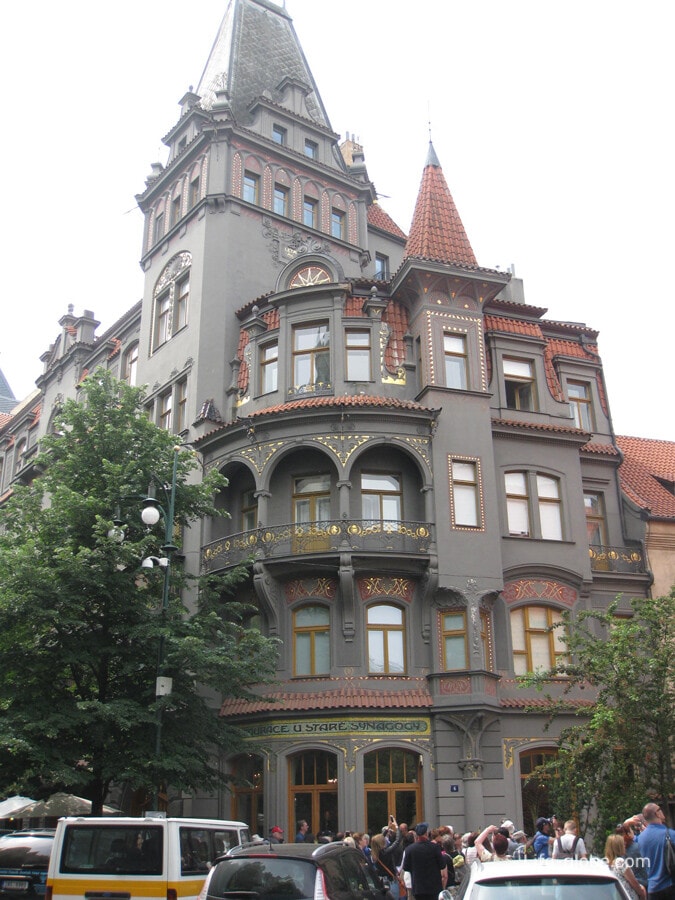
In addition to those listed, the Reform Synagogue (Beit Simcha) and the Orthodox synagogue (Chabad of Prague) are located in the Jewish quarter of Prague. There are also synagogues outside the Jewish quarter, among which stands out especially -
Jerusalem Synagogue (outside the Jewish quarter)
The Jerusalem Synagogue or Jubilee Synagogue (Jeruzalémská synagogue, Jubilejní synagogue) is the youngest and largest synagogue building in the Jewish community of Prague.
The construction of the synagogue in the pseudo-Moorish style took place from June 26, 1905 to September 1, 1906 according to the plans of the Viennese architect and experienced synagogue builder Wilhelm Stiasny by the builder Alois Richter.
The name of the synagogue "Jubilee" (Jubilee) was proposed by the Israeli Association to commemorate the 50th anniversary of the reign of Francis Joseph I.
In 1907, the synagogue passed from the ownership of the Synagogue Association to the ownership of the Prague Jewish Community. With the exception of the Protectorate, where services are still held.
The facade of the synagogue stands out with a massive arch and a large rosette window, in which there is a six-pointed star of David. The center of the western facade is decorated with Czech and Jewish inscriptions: "This is the gate of the Lord through which the righteous enter. Don't we all have the same father? Didn't God alone create us?" On both sides of the entrance, on the roof, there are two towers.

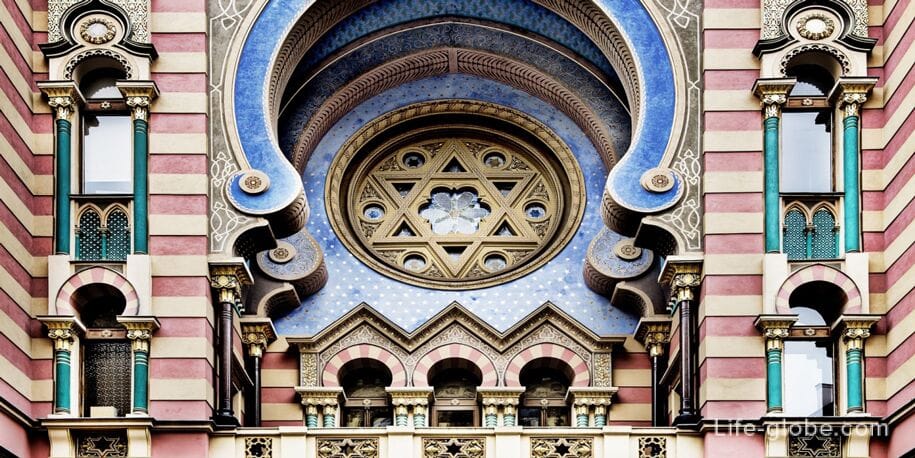
The interior of the synagogue is designed in the Viennese Art Nouveau style.
The interior decoration, colorful decorations of the nave, wall paintings and stucco were provided by František Frelich's company.
The interior of the synagogue with the temple curtain is decorated with a vine motif. Above them are the tablets of Moses with the ten laws.
The synagogue has 850 seats, the side galleries are designed for women and have separate entrances.
Entrance to the synagogue is paid. You can purchase a single ticket to the Jerusalem and Staronov synagogues (located in the Jewish quarter; described above in this article).
Website: synagogue.cz/jeruzalemska-synagoga .
Synagogue address: Jeruzalémská 1310/7, Praha 1.
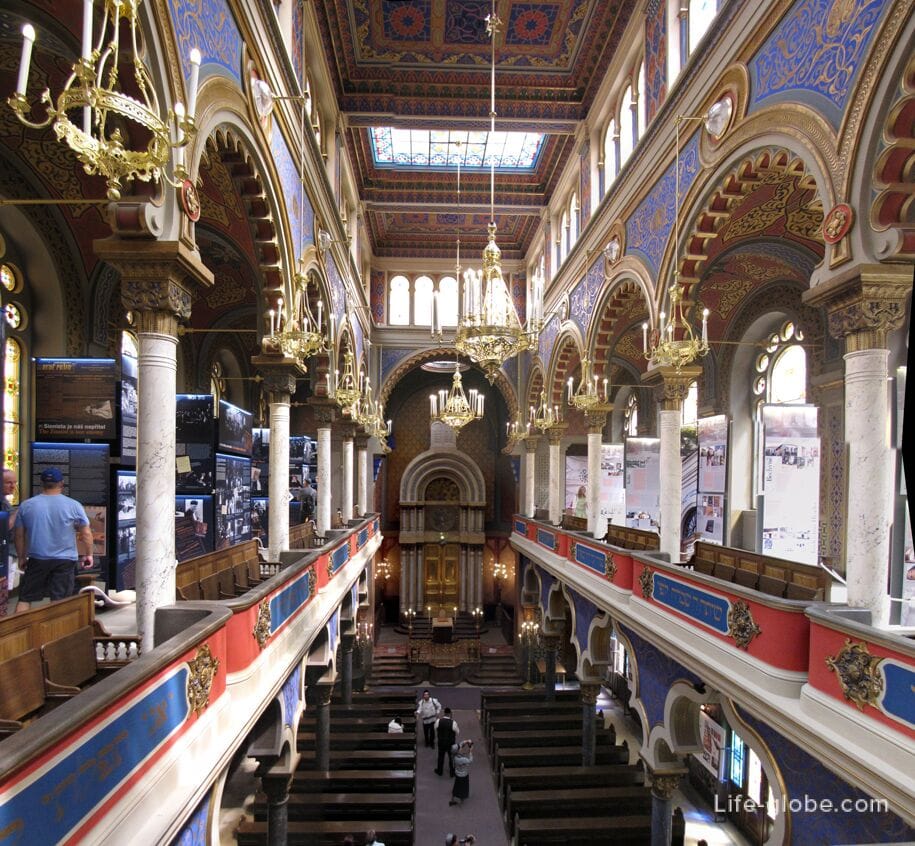

Practical information
Visiting most of the objects of the Jewish Museum in the Jewish quarter of Prague is paid.
Some objects can be visited with separate tickets. There are also complex tickets for visiting several sites.
The Jewish Quarter has an information and booking center of the Jewish Museum, where you can get information about individual monuments and permanent exhibitions in the Jewish Town, as well as about individual Jewish monuments in Prague and the Czech Republic, an overview of current museum and educational programs of the museum and other practical advice. Tickets can also be purchased at the center.
The address of the information center of the Jewish Museum: Maiselova 15, 110 00 Praha 1 - Josefov.
Website of the Jewish Museum in Prague:jewishmuseum.cz.
All accommodation facilities in Prague (hotels, apartments, guest houses, etc.), including in the historical center of the city and more remotely from it, can be viewed and booked here






